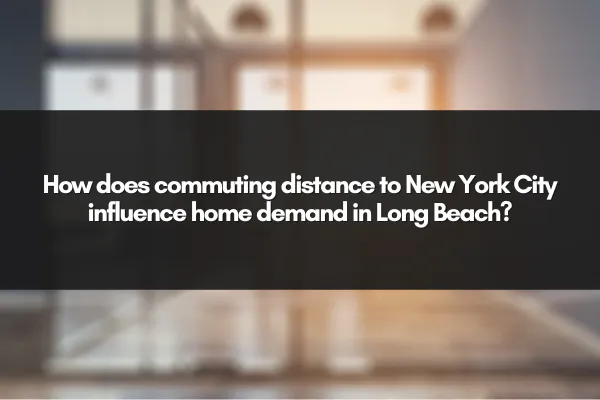
How does commuting distance to New York City influence home demand in Long Beach?
Long Beach, NY, is a hidden gem along the coast. Its picturesque views, welcoming community, and proximity to New York City make it a desirable place to call home. But what role does commuting distance play in shaping the Long Beach real estate market factors? Let’s explore how proximity to NYC influences demand and what local buyers and sellers need to know about this dynamic.
Long Beach Real Estate Market Factors at a Glance
Before diving into the commuting aspect, it’s essential to understand what drives the local market. Long Beach has experienced steady interest due to its beachside living, improved infrastructure, and access to urban hubs. Recent data indicates that proximity to Manhattan keeps property prices competitive, attracting people seeking a balance of relaxation and convenience.
The Impact of Commuting Distance
Proximity Equals Demand
The shorter the commute to New York City, the higher the demand for homes in Long Beach. Many buyers are motivated by the ability to work remotely occasionally while maintaining a manageable daily commute. This balance elevates longing for properties closer to transit links and main thoroughfares.
Transit Connectivity as a Market Catalyst
Long Beach’s proximity to subway lines and express buses significantly influences its desirability. According to reports, areas with better transit options see increased property values and faster sales. For instance, homes within a reasonable commuting radius to the Long Beach LIRR station or bus hubs tend to command premium prices.
Commuting Costs and Time as Factors
Transportation policy research reveals that the cost and time of commuting influence home demand heavily. Consumers weigh these costs when deciding whether to buy or rent. Longer commutes can suppress demand unless compensated by lower prices or unique amenities.
Why Commuting Distance Matters for Long Beach Homebuyers
Buyers are increasingly sensitive to commute times. A study shows that advancing technology and flexible remote work policies lower the threshold for what’s considered an acceptable commute. Yet, the desire for shorter commutes persists, especially among professionals seeking work-life balance.
In Long Beach, properties within a 30-minute commute to Manhattan are especially sought after. These homes offer the allure of coastal living without sacrificing quick access to urban career opportunities. As a result, they're often priced higher due to increased demand.
How Commuting Patterns Shape Long Beach Real Estate Market Factors
Supply and Demand Dynamics
As commute times shorten, increased demand drives up property appreciation. Conversely, areas with longer travel times might see stagnation or even declines if alternatives become more attractive. This pattern underscores the importance of transportation infrastructure development.
Influence of Infrastructure Improvements
Investments in transit like new bus lines or improved rail connections can shift market factors significantly. For example, if the Long Beach area benefits from reduced transit times or expanded service, expect an uptick in home demand.
Local Examples and Scenarios
Imagine a young professional working in Manhattan. She considers two properties: one closer to the Long Beach LIRR station, the other farther out. The closer property, with an estimated 20-minute train ride, commands a premium because it aligns with her desire for less commute stress.
Similarly, a family valuing suburban tranquility might accept a longer commute if home prices are lower. But increasingly, buyers are willing to pay a premium for efficient transit options, affecting Long Beach real estate market factors.
Strategic Advice for Buyers and Sellers
Buyers: Consider properties near transit hubs. A home within a reasonable commute to NYC offers long-term value, especially if remote work continues to evolve.
Sellers: Highlight transit convenience in listings. Emphasize commute times and access to transportation links to attract buyers seeking proximity.
Investors: Monitor infrastructure projects and transit enhancements. Improvements can propel market demand and property appreciation.
Final Thoughts
The relationship between commuting distance and home demand in Long Beach is clear. Shorter commutes to Manhattan and other parts of NYC significantly influence Long Beach real estate market factors. As transportation options improve and remote work persists, these dynamics will evolve but likely remain central to local market decisions.
Partnering with a knowledgeable local expert can help you navigate this landscape. For personalized insights into the Long Beach market factors and how they can benefit your real estate goals, reach out to Tom Tripodi Gil Shemtov.
Contact Information
Tom Tripodi Gil Shemtov
Top Realtors
Phone: 516-763-6131
Email: [email protected]
Website: https://tripodishemtovteam.com
